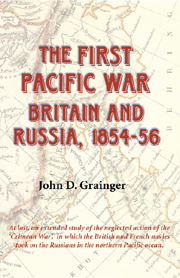Book contents
Summary
Concentration on the main events of a war can lead to the ignoring of peripheral matters, to the detriment of an understanding of the war as a whole and of other areas and events elsewhere. The ‘Crimean’ War is one such war. Its very name indicates that events in the Black Sea area have been regarded as central, even all-important. Yet the war was fought elsewhere as well, particularly in the Baltic area, but also in the White Sea and in the Pacific. It is this last area which is my subject here.
As I researched this subject, initially from the point of view of the Royal Navy, it steadily became clearer that the British viewpoint was excessively partial and limited, and that a proper understanding of events in the Pacific at the time needed to take account of the actions of Russians on land more than at sea, and that the Anglo-Russian conflict involved also the Japanese and Chinese in important ways.
Nevertheless, British naval actions were the mainspring of events, for it was in reaction to what the British did that others were moved to act themselves. The war in the Pacific began with the British and French ships looking for a single Russian ship, or perhaps two; in the end, it changed the whole balance of power in the Pacific area, bringing Russia in strength to the coast, damaging China seriously, and alerting both Japan and, above all, the United States to the importance of the region. This was not what the British had intended to happen.
- Type
- Chapter
- Information
- The First Pacific WarBritain and Russia, 1854–56, pp. ix - xiiPublisher: Boydell & BrewerPrint publication year: 2008



